California’s epic heat wave is over. Here’s what we learned

This is the Sept. 15, 2022, edition of Boiling Point, a weekly newsletter about climate change and the environment in California and the American West. Sign up here to get it in your inbox.
The heat wave is over. Now it’s time to learn some lessons.
First off, those of us who live, work and commute in air-conditioned homes and cars are the lucky ones. For the half-million Los Angeles County residents who take the bus each day, waiting at a bus stop with no shade structure can be brutal. Unfortunately, the vast majority of bus stops in L.A. County don’t have any shade — and only half have benches, which can be searing hot, my colleague Rachel Uranga reports. As the region expands public transit, this badly needs to be fixed.
Unhoused people are especially vulnerable to injury and death during heat waves. Some civil rights advocates wonder if rising temperatures could finally prompt California to establish a legal right to housing or shelter, L.A. Times columnists Anita Chabria and Erika D. Smith write. And what about cooling centers, you ask? Well, they’re often not super effective. L.A.’s dedicated cooling centers averaged just 21 people per center per day during the recent heat wave. Summer Lin looks at why.
And although California managed to avoid power shortages — barely — the climate chaos wreaked havoc on the electric grid and other infrastructure. In Northern California, four cities needlessly shut off power after misunderstanding a communication from the state grid operator. Wildfire smoke and clouds from a tropical storm blotted out the sun in parts of the state, causing solar power production to drop. Extreme heat knocked out a Twitter data center in Sacramento.
We’ve suffered through enough of these climate-fueled heat spells that state officials are already learning some lessons. Under a bill signed by Gov. Gavin Newsom last week, California will become the first state to rank heat waves like hurricanes. The goal is to help local governments take action to protect the most vulnerable, The Times’ Hannah Fry and Phil Willon report.
So now the focus turns to the future. How do we speed the transition from fossil fuels to climate-friendly energy? And how do we do it while avoiding blackouts, keeping energy bills from getting out of control and making sure the solutions are designed to benefit low-income families and people of color?
It’s a delicate balancing act. It’s also the subject of a panel discussion I moderated last week at USC, hosted by the Los Angeles Business Council.
The panelists included several government officials charged with solving these problems, including Marty Adams, general manager of the L.A. Department of Water and Power; Stacey Crowley of the California Independent System Operator, which operates the power grid for most of the state; Natasha Keefer of Clean Power Alliance, a government-run electricity provider in Los Angeles and Ventura counties; and Alice Reynolds, president of the California Public Utilities Commission.
Rounding out the discussion were representatives from two major renewable energy developers: Tom Buttgenbach, chief executive of 8minute Solar Energy, and Hunter Armistead, chief development officer at Pattern Energy.
Here are some highlights from the first half of the panel, edited and condensed for clarity. You can watch the full discussion here.
**
ME: Stacey, most people don’t usually pay any attention to the Independent System Operator. Many Californians haven’t even heard of it. But this week your agency has been the center of attention, sending out Flex Alerts and warning of rolling blackouts if people don’t save electricity. What has life been like at your headquarters in Folsom?
STACEY CROWLEY: As you can imagine, it’s been busy. The office has been more full of people than it has been since pre-COVID.
It’s taken a lot of coordination and communication. It has been an everyday affair. We have a day-ahead energy market, so we know the day before what things might look like the next day. That’s why we put out Flex Alerts day by day — to know what the system has to bring in terms of resources and what the electric demand might be.
Every day is different. Even though it’s been hot really consistently, the conditions have been different throughout the week. The condition of certain generating units, transmission lines, fires — it changes day by day.
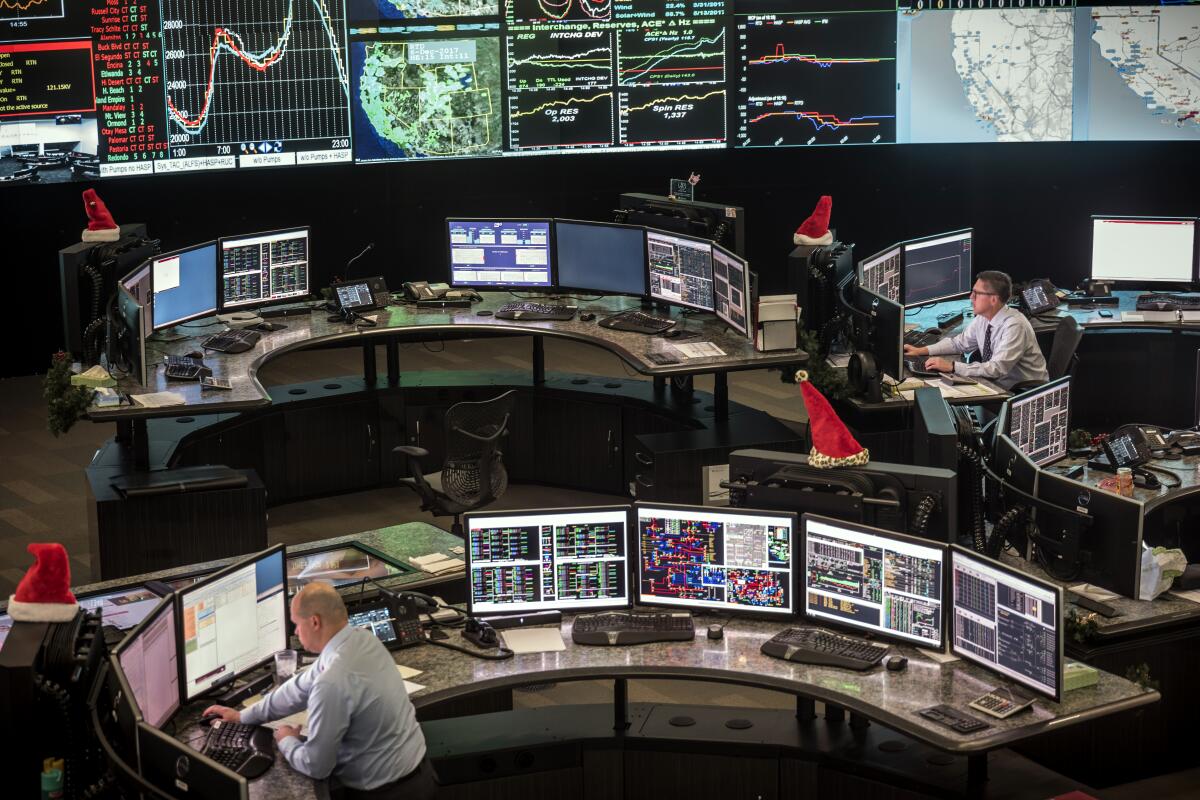
ME: How long is it sustainable to deal with these types of grid emergencies by begging people to use less electricity in the evening, rather than having some strategy in place that’s more permanent, or at least less frantic?
CROWLEY: We all recognize we can’t ask people to do this all the time. Clean energy resources are coming online as quickly as they possibly can. We’ve got solar and storage coming on. We saw nearly 4,000 megawatts of storage perform this week, which is great. And it’s being used when we need it the most, when the sun goes down.
ME: Alice, the Public Utilities Commission has taken criticism for what some people see as its role in stranding the state with insufficient power. After the August 2020 rolling blackouts, Steve Berberich, president of the Independent System Operator at the time, said it was largely the commission’s fault for not getting clean energy projects built faster.
Does the Public Utilities Commission bear some blame? And what have you been doing to get more batteries and other clean energy projects built faster?
ALICE REYNOLDS: After the 2020 rolling outages, there was a lot of scrambling to figure out what happened and why. We realized the state needed to move really quickly to increase generation. So we’ve been getting lots of batteries installed. We went from about 200 megawatts in 2020 to almost 4,000 megawatts now. And they’re performing exactly as we would like. They’re charging up during the day when we have solar, and they’re discharging at the evening peak when we need them.
We also worked on demand-response programs that pay people to use electricity at different times. Some of those programs already existed. Some of them were new, and some of them were geared toward emergency situations.
And this really is an emergency. We’re seeing temperatures we’ve never seen before, and the length of the heat wave is something we’ve never seen before. And so we’re planning for the extremes, but then the extremes keep getting more extreme.
ME: Can Californians expect that at some point soon — whether it’s next year or two or three years from now — we’ll have enough solar and storage, and other clean energy sources, that we won’t be in this same situation again?
REYNOLDS: That’s absolutely the goal. And our planning is now taking into account climate change impacts. Rather than looking at trends from the past and then projecting out, we’re trying to project forward into the future.
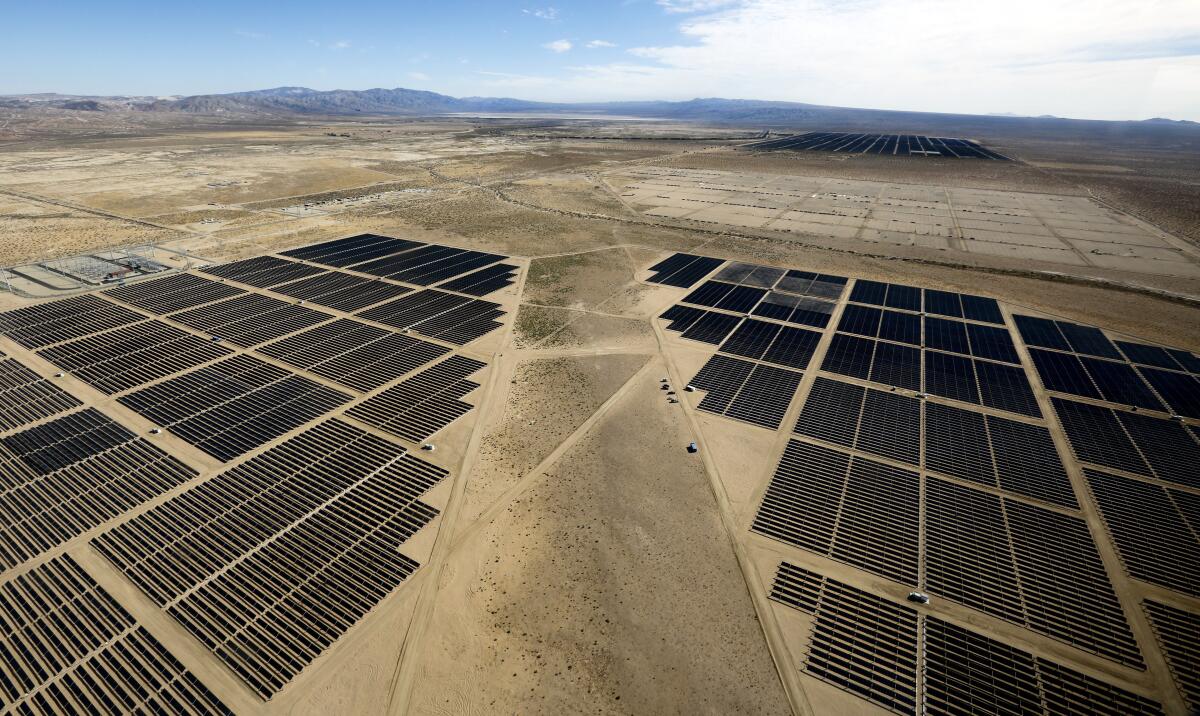
ME: During the peak hours the last few evenings, California has been getting more than 50% of its electricity from natural gas, a fossil fuel. Tom, your company has been building a lot of solar-plus-storage projects, which can replace some of that gas. What do you think can be done to help get projects built faster?
TOM BUTTGENBACH: My company has close to 20 gigawatts under development in California. And we’re glad to see the Public Utilities Commission is now transitioning. For many years the commission said we don’t need any more power lines in California. But now the message has gotten through that we do need to expand the grid, to allow for more renewable energy.
We’ve done a study internally that shows that for $10 billion, we could add 75 gigawatts of transmission capacity to the California grid. That is more than a doubling. And there are technologies today — lightweight, high-capacity conductors — that allow you to expand the capacity of existing lines relatively quickly without big hurdles in terms of permitting.
It’s important to think about this energy transition as not only dirty to clean but also getting us to the next generation of technologies. I was just at Burning Man, and we installed the first solar and energy storage system there to power five RVs — which is not much, but with air conditioning running at 100-plus-degree temperatures, the system performed flawlessly. The diesel generator sets that were used in other camps failed 20% on average.
ME: Hunter, your company has been building wind farms in New Mexico and transmission lines to help get that clean power to Los Angeles. Talk about what it took to get that done and what you’re working on next.
HUNTER ARMISTEAD: We basically saw that the vast wind resources in New Mexico would be very complementary to the West, in terms of the hours when it blows. We were able to expand the New Mexico grid by building about 150 miles of new transmission that unlocked a full new gigawatt of wind that we were able to develop. And the Los Angeles Department of Water and Power was able to buy the vast majority of it at a very good price, which we’re proud of.
That was an incredibly ambitious project. And maybe we’re a little nuts, but next year we hope to start construction on a 550-mile power line from New Mexico to Arizona, which is going to help us move 3 gigawatts of wind power to California.
But think about it. Each of those projects, the development is about 10 years. I agree with Tom that reconducting and doing certain small upgrades to the grid has to happen. But we have to get to the point where when we do something transformative like these long power lines, it doesn’t take 10 years. Because we don’t have 10 years.
ME: Part of the reason it’s difficult to build new transmission is because of permitting challenges, right? Environmental rules and opposition from local landowners.
ARMISTEAD: There’s never been a place that people are not going to oppose your transmission.
ME: Or almost any type of renewable project, I’ve found.
BUTTGENBACH: That is conventional wisdom, right? But we’re able to add a lane to the 405 Freeway. That costs about as much as building out the entire transmission system in California. Where are our priorities?
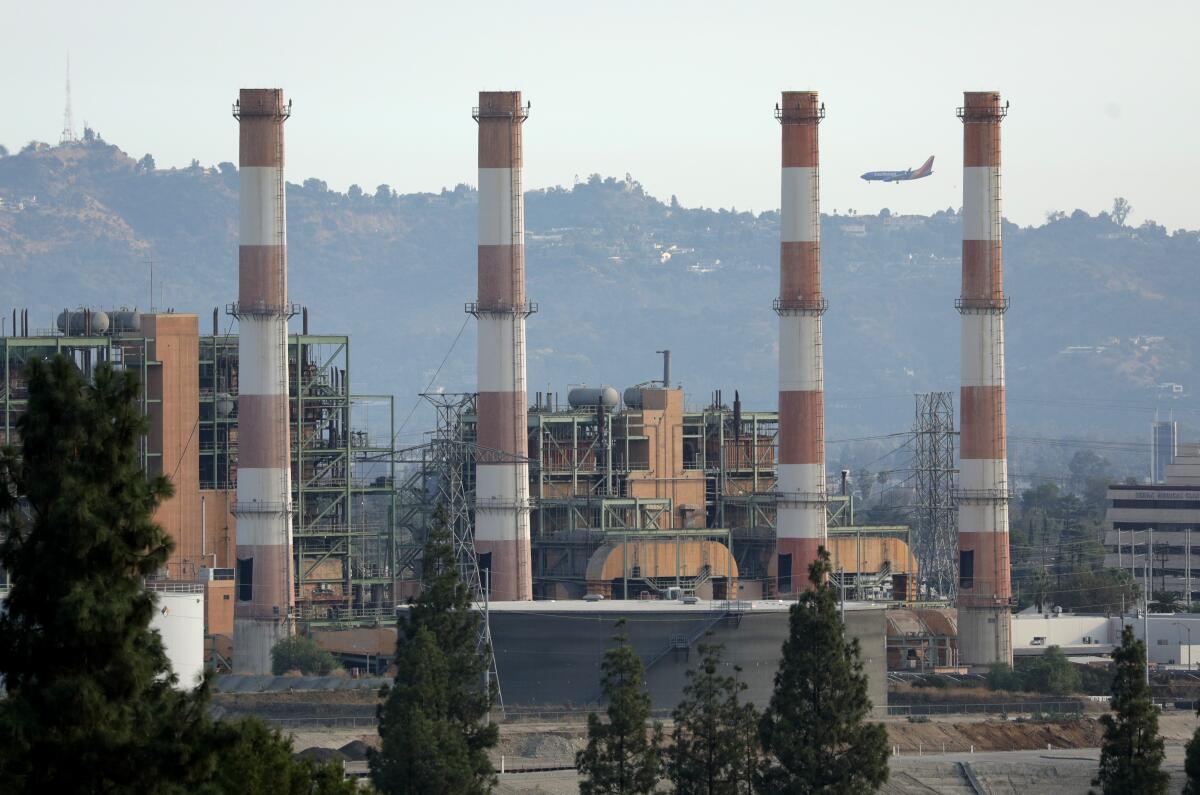
ME: Marty, let’s turn to what’s happening in Los Angeles. The Department of Water and Power operates its own electric grid separate from the rest of the state, and we’ve been nowhere close to power shortages or rolling blackouts here. Why has that been the case? And how are you going to keep the lights on during the speedy transition you’re planning to 100% clean energy by 2035, a full decade ahead of what’s required by state law?
MARTY ADAMS: We want to make sure the city always has adequate power, and as we take steps moving forward to convert to clean energy, we don’t lose that reliability. In other parts of the state, gas plants have gone offline as people see there’s no future for gas. People stop maintaining them, stop building them. So there’s just less generation available.
ME: Whereas here in Los Angeles, your department still operates several gas plants.
ADAMS: We still have our four gas plants in the city. We know we need electricity generation located here in the Los Angeles Basin. That’s not going to happen with batteries, not unless we take 10% to 20% of the land in L.A., take all the houses and buildings off of it and put batteries there instead. And that’s assuming that people will allow massive battery farms in their communities, which will probably not happen. And so we have to have local generation.
We’ll continue to add batteries in L.A. We’ll add batteries at all of our power plants. and that’ll help a lot of the time. But we need something above and beyond what classic batteries will do. And we’re looking at green hydrogen as being the key to that.
ME: Right, you’re planning to convert your gas plants to run on hydrogen, and also your coal-fired plant in Utah. How much confidence do you have that it’s going to work and work well for everyone? Nothing like this has ever been done on such a large scale, and green hydrogen is still relatively expensive. And while burning hydrogen doesn’t create all the same nasty pollutants as fossil fuels, there can still be nitrogen oxide emissions in disadvantaged communities.
ADAMS: Unless someone comes up with an idea that no one’s thought of yet, there is no other clean fuel for the future. And we’re going to need a clean fuel. So I’m convinced this is where we’re going. You have all the big turbine manufacturers racing to get to 100% hydrogen units. And they’re going to reduce nitrogen oxide emissions because they see this as the future globally.
**
Again, you can watch the rest of the discussion at this link, if you’re interested. It starts around the 33-minute mark.
Here’s what else is happening around the West:
WATER AND FIRE
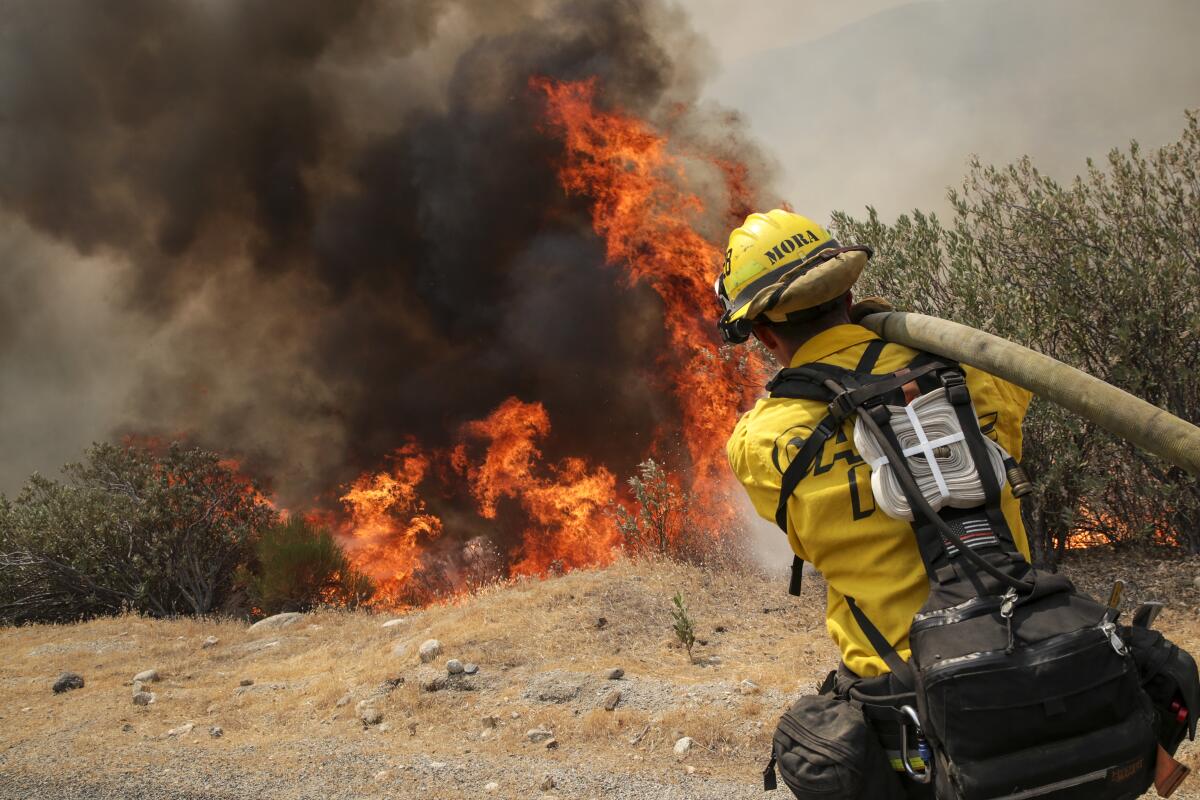
The U.S. Forest Service will start allowing prescribed burns again — but only with restrictions that tribal officials and other fire experts say add unnecessary red tape and will limit their effectiveness. Details here from The Times’ Alex Wigglesworth. In other fire news, a lumber mill says hot ash may have ignited the Mill fire, which killed two people in Siskiyou County. And Pacific Gas & Electric reported “electrical activity” on a transmission line near where the Mosquito fire ignited, although it’s not yet clear if that caused the blaze, which has surpassed the 50,000-acre mark. My colleagues Connor Sheets and Libor Jany wrote about the Cal Fire helicopter pilots dropping water on Southern California’s Fairview fire in the dead of night. And as chaotic climate conditions continue, experts worry the worst of the fire season could be yet to come, Summer Lin and Jessica Garrison report.
A tidal marsh restoration project in California’s Yolo Bypass is supposed to help an endangered fish, the delta smelt — but critics see it as a canard meant to benefit Westlands Water District, an agricultural powerhouse. Here’s the story from my colleague Ian James, who writes that some environmentalists say the land being restored is too far above sea level to flood during high tide, and that the project is being funded by Westlands only to “check the box” of restoration. Not far from there, KQED’s Ezra David Romero writes that just a few inches of sea level rise could push groundwater polluted with toxic chemicals into formerly redlined neighborhoods in West Oakland, worsening a legacy of environmental racism.
As farmers fallow more land in California’s Central Valley — due to drought and groundwater regulations — more dust could be kicked up, polluting low-income communities of color that already suffer from some of the nation’s worst air quality. That’s according to new research from the Public Policy Institute of California, which says some form of dust control will be needed as pumping restrictions phase in under the Sustainable Groundwater Management Act, Caroline Tracey reports for High Country News. In another complication for California’s efforts to cope with water shortages, a court ruling could make it harder for state officials to curtail pre-1914 water rights. Details here from the Sacramento Bee’s Dale Kasler and Ryan Sabalow.
“I realize grass is not for everyone, but why are we singled out?” L.A. Times columnist Gustavo Arellano talked with the University of California system’s preeminent turf researcher, who is trying to breed more drought-tolerant grasses for lawns. My colleague Lisa Boone, meanwhile, wrote about a Los Angeles family whose drought-tolerant front yard garden — part of a climate-conscious home — originally freaked out the neighbors, before winning them over. These conversations aren’t going away anytime soon, especially with an expected third year of La Niña tipping the scales toward continued drought, Hayley Smith writes. And while everyone needs to conserve, water restrictions often play out unevenly across communities, Soudi Jiménez reports.
POLITICAL CLIMATE
The Texas company whose pipeline caused a massive oil spill off the Southern California coast last year agreed to plead no contest to state environmental charges and pay $4.9 million. Details here from The Times’ Hannah Fry. In other coastal news, El Segundo is suing Los Angeles over fallout from last year’s sewage spill, including what El Segundo officials say are continuing noxious odors from L.A.’s sewage treatment plant, Christian Martinez reports. Farther south, the California Coastal Commission says Orange County needs to tear down a fence being used by a major Republican donor to block access to public land at Upper Newport Bay Nature Preserve, Noah Goldberg writes. And in sad news, Times columnist Steve Lopez wrote a tribute to Sara Wan, an “eco-warrior” who fought for decades to protect the California coast. She died this week at 83.
President Biden’s first new national monument could be a World War II-era military training camp along the Continental Divide in Colorado. Some soldiers called it “Camp Hell” as they learned to ski, snowshoe and rock climb, skills that helped them defeat the Axis in Italy, the Washington Post’s Maxine Joselow writes. Also in Colorado, Steve Wells, the heir to a ranching and drilling dynasty, is spending millions of dollars to unseat Gov. Jared Polis, in part out of opposition to the Democrat’s oil and gas restrictions. Wells canceled a solar project so he could spend more money against Polis, Andrew Kenney reports for CPR News.
In Mary Peltola’s Alaska hometown, rising temperatures and gold mining threaten salmon runs and tribal subsistence culture. After defeating Sarah Palin in a special election last month, Peltola is the first Alaska Native to serve in Congress — at a time of climate crisis. “The land and culture that sustained her as a child now face a series of existential threats that are redefining the political landscape of the state — perhaps forever,” Will McCarthy writes for The Times.
AROUND THE WEST
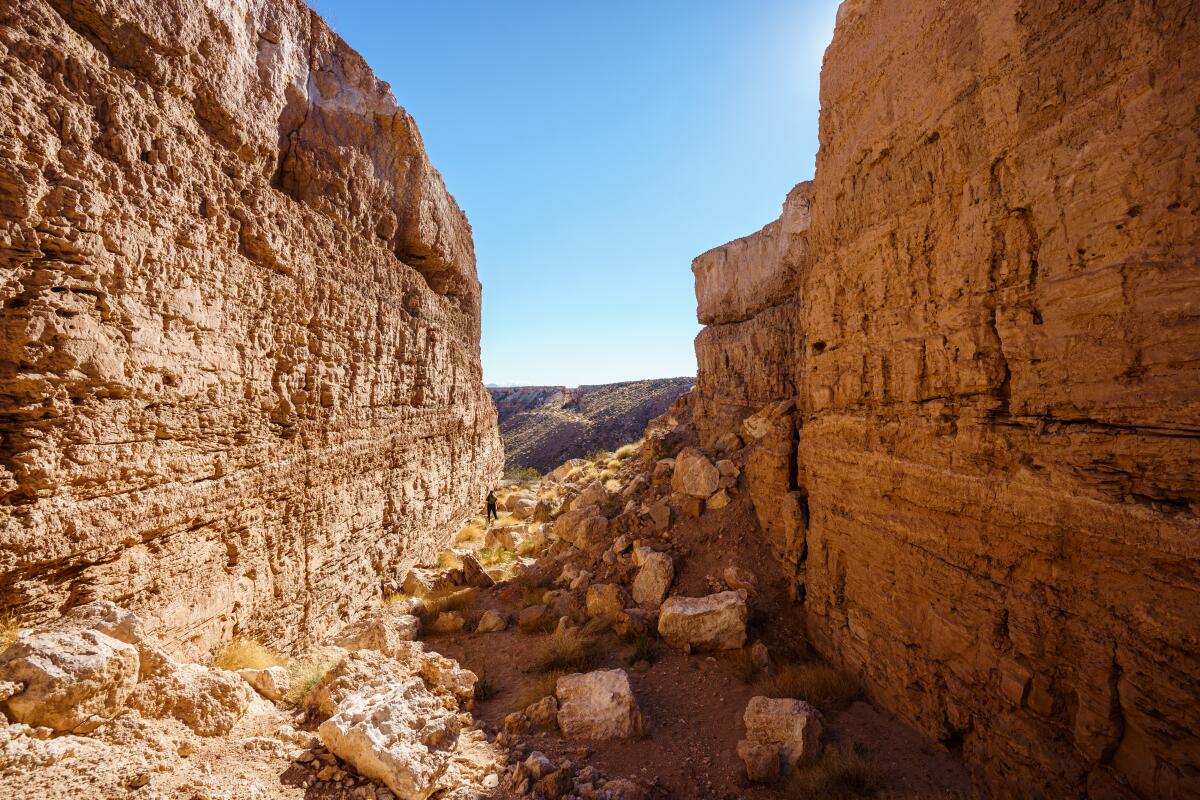
“Instead of cultivating the land for agriculture, land artists like Heizer physically altered the landscape into something with cultural value, alchemizing colonization into an art form and making it monumental.” A few weeks ago in this newsletter, I linked to a glowing New York Times piece about “City,” an enormous landscape art installation by Michael Heizer at Nevada’s Basin and Range National Monument. Writing for Grist, Tristan Ahtone has a powerful response, writing that “City” is built on Paiute land seized from the tribe “without treaty and without a single payment ever being made by the federal government or residents to its Indigenous caretakers.” He describes the artwork as “a monument to the power of violence.”
Scientists shimmied into a damp underground cave in Wyoming to painstakingly help build the past climate records that future climate models are based on. High Country News reporter Emily Benson and photographer Lindsay D’Addato joined the scientists, and their story is pretty amazing. The research involves collecting water droplets falling from the ceiling of the cave, and analyzing the stalagmite pillars growing from the cave’s floor. There’s a lot at stake for preparing for future climate changes: “We’re pinning our faith on these models to deliver accurate projections,” one climate scientist told Benson.
Two Bay Area high schoolers discovered two new species of scorpion on dry lake beds in the California desert — and solar farms may threaten their habitat. Here’s the story from my colleague Jonah Valdez, who writes that the students originally saw a picture of one of the scorpions on the website iNaturalist. In other wildlife news, the California Department of Fish and Wildlife is hiring its first-ever beaver restoration unit, which will work with beavers to help bulwark natural systems against climate change, Nathan Solis writes. Super cool! And here in Southern California, a $30-million campaign is underway to create a 96-acre wildlife corridor on the Palos Verdes Peninsula that would protect several species of butterfly. Melissa Hernandez has the details.
Meet the women hunting Burmese pythons in the Everglades. I realize this isn’t the West, but I couldn’t help myself. The Times’ Susanne Rust has a fascinating story about bounty hunters prowling Florida swamplands in the middle of the night, capturing and killing invasive pythons in exchange for payment from the state. And of course there’s a climate change angle: Rising temperatures are likely to aid the predator’s expansion because overnight cold spells are one of the few things that can kill them.
THE ENERGY TRANSITION
If you thought California’s power supply issues were bad — well, they’re worse in China. Skyscrapers in downtown Shanghai went dark for two days last month as a historic drought sapped hydropower dams and record heat drove air conditioning use, The Times’ Stephanie Yang reports. One possible solution, for China and California both: New technologies under development could make A/C units more efficient, while also ending the use of planet-warming chemicals known as HFCs, the Washington Post’s Shannon Osaka writes. Another possible solution is being demonstrated in Utah, where Warren Buffett-owned utility company Rocky Mountain Power is operating thousands of home battery systems to benefit the grid, per Canary Media’s Julian Spector.
California lawmakers approved a bill that could finally make community solar take off. “Community solar” generally refers to small, local solar farms that power surrounding neighborhoods and can keep the lights on during outages on the larger grid, while reducing local energy bills. Canary Media’s Julian Spector wrote about the legislation. By limiting reliance on the big grid, community and rooftop solar installations can also reduce the risk of long-distance power lines sparking wildfires. That’s now a concern in several states, with Washington’s Puget Sound Energy recently following the lead of utility companies in California and Oregon by cutting off power to customers to prevent wildfire ignitions, as Rebecca Moss reports for the Seattle Times.
ONE MORE THING
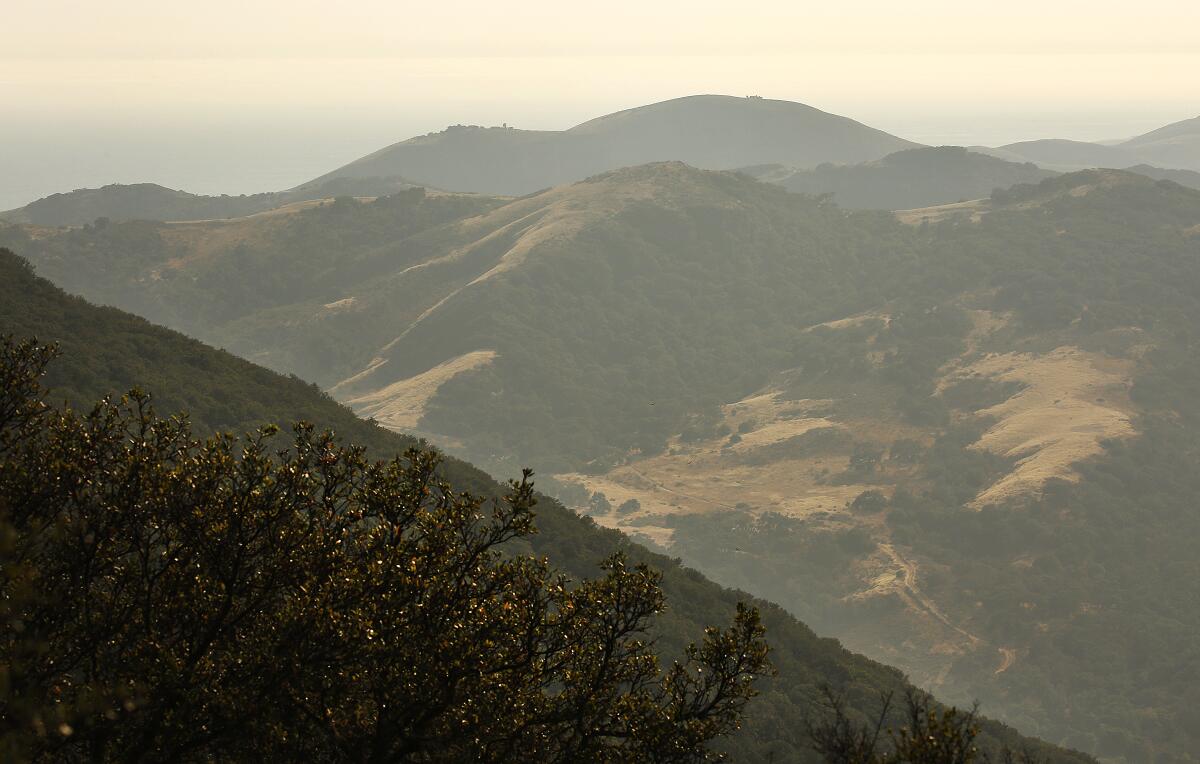
Please, please, please do not hike during heat like we experienced last week, unless you are beyond 100% sure you know what you’re doing — and even then, it might be a bad idea. That was my main reaction to this tragic story by Gregory Yee, about a Ventura hiker who left the trail to find help for his heat-stricken girlfriend, only to be found dead four days later.
More broadly, global warming is changing the nature of hiking in the West. Just see this scary-but-engrossing New York Times piece about how heat, fire and smoke are transforming the experience of trekking the Pacific Crest Trail. “Nearly everyone I met counted themselves lucky to be hiking the PCT of 2022 as opposed to the PCT of 2032 or beyond,” Rowan Moore Gerety writes.
So please, stay safe. Sign up for emergency alerts of all kinds. Keep cool. And don’t give up.
We’ll be back in your inbox next week. If you enjoyed this newsletter, or previous ones, please consider forwarding it to your friends and colleagues. For more climate and environment news, follow me on Twitter @Sammy_Roth.
Toward a more sustainable California
Get Boiling Point, our newsletter exploring climate change, energy and the environment, and become part of the conversation — and the solution.
You may occasionally receive promotional content from the Los Angeles Times.




